This little Olympus mju-iii wide 100 became a deviation from a path. If I’d followed the results of a little poll I did, I’d be reviewing the Petri Color 35 now. But when I was given this Olympus the other day, it somehow pushed in the queue. My relationship with It started in a moment of turmoil when I grabbed it and a roll of film just as I was leaving the house to go to the hospital with my wife a week or so back. The results of which ended up being some of my favourite shots I’ve taken in a while. Ordinarily I’d have written a “one roll review” of this camera, but because of that day I’ve decided to split this post into two parts
Part 1, Roll 1 – the hospital visit
I’m not quite sure what it says about me that even under the circumstances of having to rush to hospital with my wife, I still reach for a camera when I leave the house…? Regardless of my motives for reaching for a camera, it was the Olympus I reached for. This was primarily because it was the only automatic camera I had at home that didn’t have a roll of colour film in it – I just wasn’t in any mood for shooting colour that day – nor for that matter was I in the mood for thinking too hard about taking photos.
Interestingly though, beyond these prerequisites, when I reached for it there were a few specification requirements that went through my head – a mini checklist if you like. This spur of the moment checklist, whilst fleeting at the time, became a focus of my thoughts once the boredom of sitting around in the hospital all day set in. Whilst I was in no mood for starting writing a post about the camera that day, I did think it worth while taking a moment to write down the checklist I had mentally gone through. It was as follows:
- Fully automatic but easy to manipulate into getting the exposure I want
- 28mm lens at the wide end – for intimate but contextual documentary shots
- Quiet and very small – I’m going to be in a hospital, I don’t want to alarm people
The more I thought about this list the more I realised just how ideal a choice the little Olympus had been. These are pretty much this cameras key selling points, and it’d been right there waiting for me ready to be picked up in a hurry.
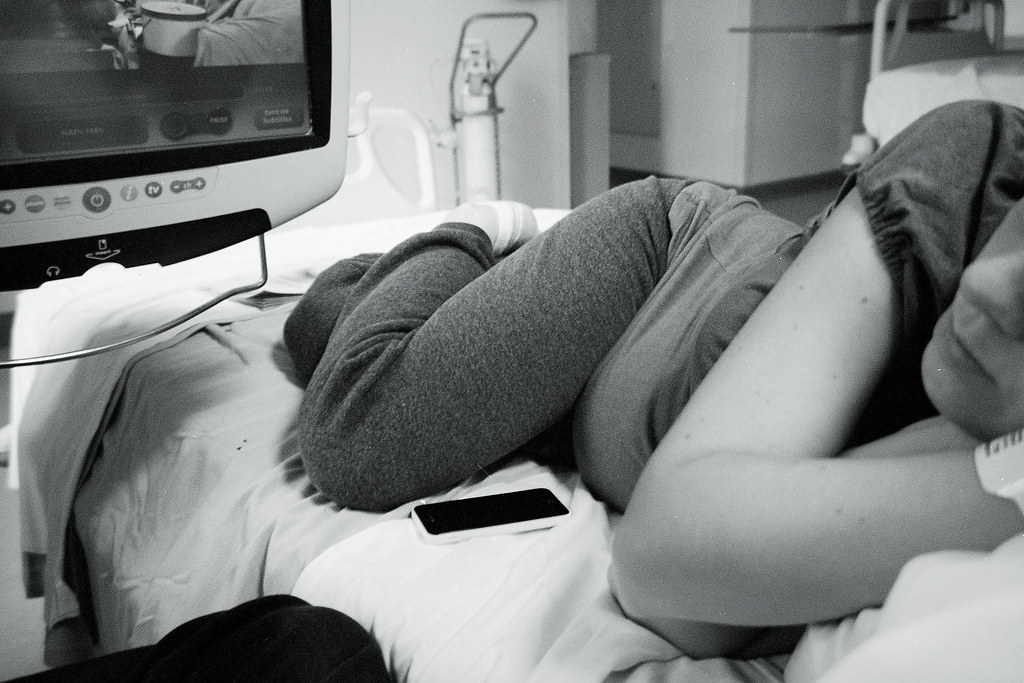
These points of note on face value might seem like a quite easy set of specifications – surely within my camera collection I have stacks of cameras that fulfil this brief? Well, as it goes, not really. I don’t have that many 28mm lensed cameras for a start – there aren’t all that many out there to choose from. My two favourites, the Ricoh GR1 and Minolta TC-1 are both quite a bit more noisy than this Olympus. I could have taken the Leica iiia and 28mm color-skopar but whilst very quiet, its just a bit too much of a camera for taking into a hospital – I wasn’t there as a photographer, I was there as a husband who anticipated getting bored and wanting to occupy himself taking a few snaps in the hours between finding out everything was going to be fine and the eventual discharge from hospital.
Thankfully, Hannah’s condition was not as serious as it perhaps could have been, so my optimistic anticipation of that down time between the all clear and home time came sooner rather than later. Fortunately for my desire to keep myself entertained taking photos they put us in an otherwise empty ward in a bed by a window. This gave me plenty of opportunities to snap away, and for my first roll of black and white in some months I ended up being very happy with the results. But moreover very happy with how the spur of the moment choice of camera had panned out.
So, for the benefit of this post, whilst I’m not going to draw all of my conclusions from that one shooting situation, it does provide me with a lot to say about the camera via the three key features that made it so suitable for the…
The Olympus mju-iii wide 100 auto exposure
As mentioned, the first specification I wanted was a camera that was fully automatic, but easy enough to manipulate into taking the photo I wanted it to take and not the one it might guess. As such, I wanted a camera that had some way of manipulating exposure if I felt I needed to. In the case of the Olympus mju-iii wide 100, this is a spot meter feature.
One shot spot meter
Point & shoot compact cameras that allow the separation of the function of autoexposure and autofocus tend to be the most useful. Unfortunately the Olympus mju-iii wide 100 is not one of them. But, like its older fixed focal length sibling – the mju-ii – it does have a spot meter. Whilst it can be a little tricky to use, it definitely gave me some sense of advantage when shooting in the hospital. Knowing that lens of the camera was quite slow, and knowing that I had Ilford XP2 loaded – a film that isn’t too fussed by at least two EV of underexposure – I was able to use the spot meter expose for much lighter parts of the scene than the normal centre weighted autoexposure might have done off its own back. Such is the beauty of XP2, it’s not actually that obvious which photos I shot like this with, to the point in fact that I can’t specifically remember which ones I did – apart from at least, this wider shot of the room:
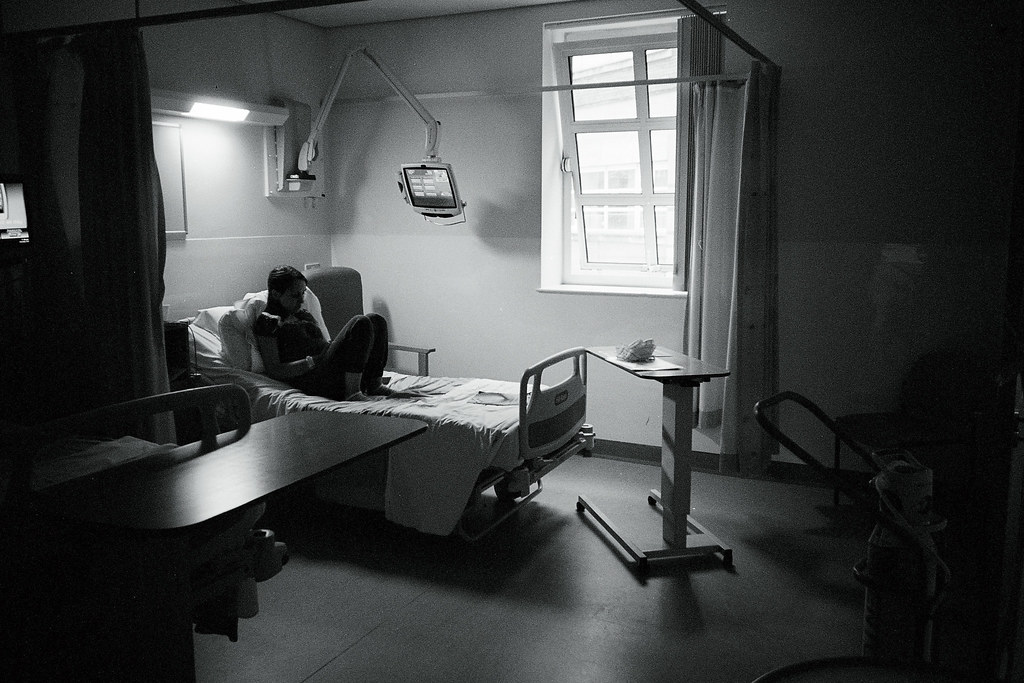
I wanted much of the outer parts of the frame to be cast into as much shadow as possible, so I metered off the wall next to the window. Perhaps through luck as much as anything else, the d&p machine at Max Speilman – which actually seems to do a very fine job of scanning XP2 – did a fine job of interpreting the negative.
The spot meter only stays active for a single shot, so there’s no forgetting to turn it off. This is handy, since there is no warning it’s on. You just have to push the tiny button on the back, point the camera and take the photo. If you want to use the spot meter again, you have to press the button again. Fiddly, yes; lacking any sort of feedback that it’s worked, certainly; but at least you get some sense that you’re in some small way making a choice about the exposure.
Sensible program AE
Beyond the use of the spot meter, I felt the camera did an admirable job of not picking too slow a shutter speed. What this tends to point to is an AE program mode that favours larger apertures and shorter shutter speeds over longer shutter speeds and smaller apertures. It might seem odd, but the latter is what many compacts do, and as I’ve quite frequently said on this blog is something that makes me not even bother trying them. Certainly within the hospital I didn’t get any shots that I was disappointed with in terms of the cameras shutter speed – this gave me a big boost in the confidence I had in this camera.
28mm lens
My second requirement was a 28mm lens for intimate but contextual documentary shots. As you might guess by the name, the Olympus mju-iii wide 100 sports a wide angle lens that zooms to 100mm – a very useful range by all accounts.
I’ve not shot an awful lot of wider angle photography for a little while. In fact, until quite recently I started feeling myself slip toward just shooting 50mm and sometimes longer. That was until I went to Cornwall earlier in the summer and shot a lot of 28mm landscapes. After the holiday, I then went on to shoot with a 16mm Hologon – this made me remember just how easy shooting 28mm really is. As a focal length it sits just at the edge of not looking odd. Wide enough to capture context, but not so wide everything distorts.
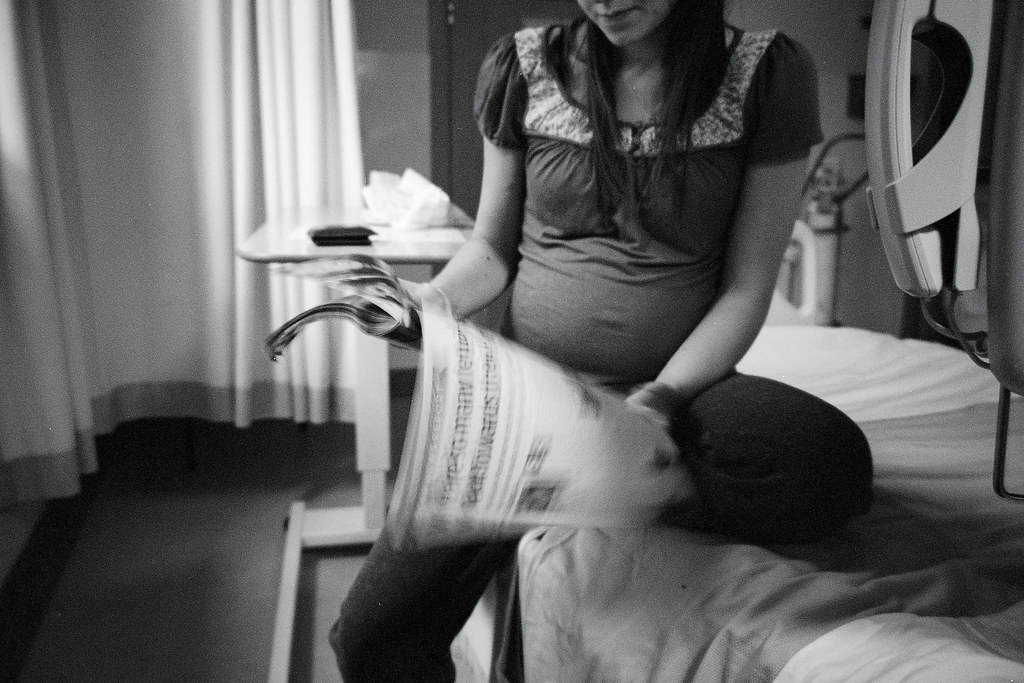
For documentary photography this makes it a very good choice I think. The only problems I felt I was up against with the Olympus mju-iii wide 100 were the relatively slow f/4.6 aperture at 28mm and the close focus distance only being 60cm. The slow lens I overcame by erring toward underexposure with the spot meter, and whilst the close focus did limit me a little bit, I’m not sure I felt I lost any shots because of it – in reality, I’m quite used to these shooting distances because of the Leicas.
I shot pretty much everything at 28mm in the hospital, maybe a little zoom on a couple of the photos, but broadly I stayed wide. As can be in the results, whilst it might not be as bitingly sharp as the fixed focal length mju-ii, it does an admirable job.
A quiet camera
Quiet and very small were my final requirements – I’m going to be in a hospital, I don’t want to alarm people waving a camera around the place. The low level of noise this camera makes were something I noted when I first picked it up. It does of course make some noise, it has to move the lens, open and close the shutter and wind the film on for every photo like every other camera in its class. But unlike many, even some of the best of them, it does it with a low toned whisper – perfect for not disturbing other people in a hospital.
One roll in…
I must admit, I was thrilled when I got the above photos back. I hadn’t expected much at all really. I’d been shooting with a fairly slow lens indoors and is not really had my head in the game. The results had come out great though, much better than I’d expected – this little Olympus mju-iii wide 100 was – at least for a few moments – my new favourite camera.
So what next for it? My first inclination was to end the review here, call it a one roll review shower it with praise and move on. But having shared this single slightly weary day with it, I felt I had bonded with this camera, but had hardly covered the extent of its function…
Part two, roll two
Since I’d shot a roll of XP2 the first roll, for my next trick I thought I’d shoot a roll of Fuji Superior 400. I used to really dislike Fuji superior, but that was until I realised I wasn’t properly exposing it. To me, it looks rubbish under exposed, it has to be bang on correct exposure to look good, and to be at its best, ever so slightly over exposed is the way forward. I felt this would test the cameras meter a little better than XP2.
Actually ended up not shooting the whole roll. Half way through it I’d done a mid roll rewind after deciding I wanted to shoot some XP2 in it again. In the end I up put the XP2 in the Petri instead, but when I went to load the Superior back into the Oly I realised I had forgotten what frame I’d shot it up to. Rather than risk going over the frames twice, since it’s such cheap film I just decided to get it processed. Fortunately I took enough fairly average photos to draw a few conclusions.
Long end lens speed and performance
One of the things I really felt I missed out on discovering with the first roll was how useful the lens is at the long end. Sometimes with these sorts of cameras the long end of the zoom can be pretty useless even in day light. As mentioned above, this comes down to a combination of smaller apertures – f/11.9 in this case – and poorly programmed shutter speeds. Fortunately, this camera – like the AiBORG I recently reviewed – seems to do quite well in this regard. I took a few shots at the 100mm end, and despite me not paying too much attention to holding the camera steady, I got some admirably shake free photos. Results were pretty sharp too, perhaps a fraction less sharp than the wide end, but this seems pretty common with the compact zoom cameras.
I did notice a fair bit of vignetting in a couple of shots mind…
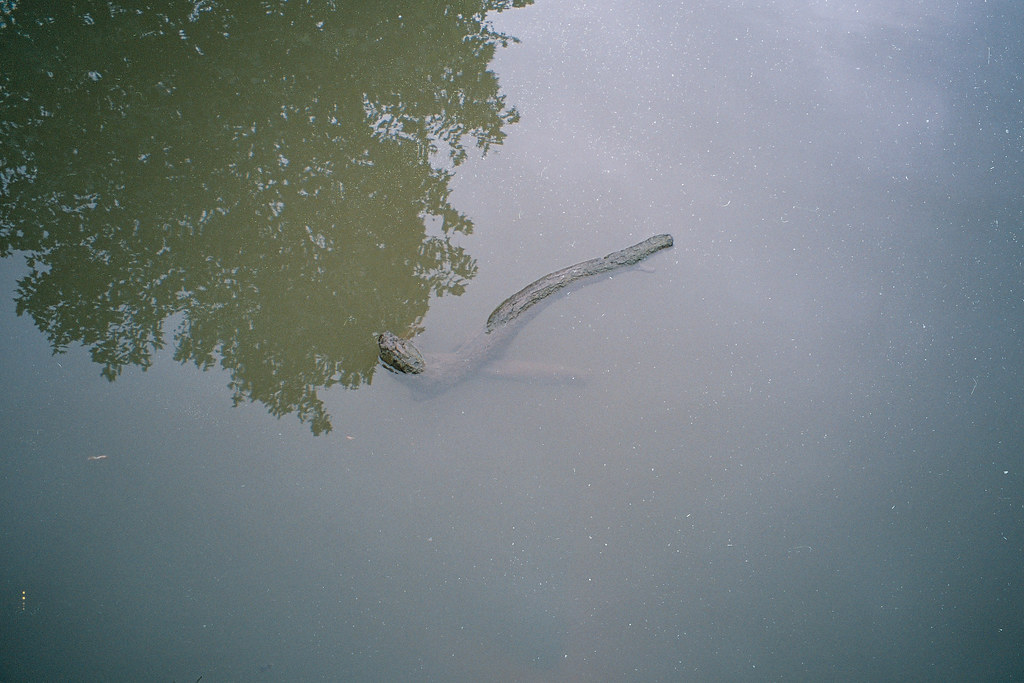 …and a couple where I got a fair bit of flare
…and a couple where I got a fair bit of flare 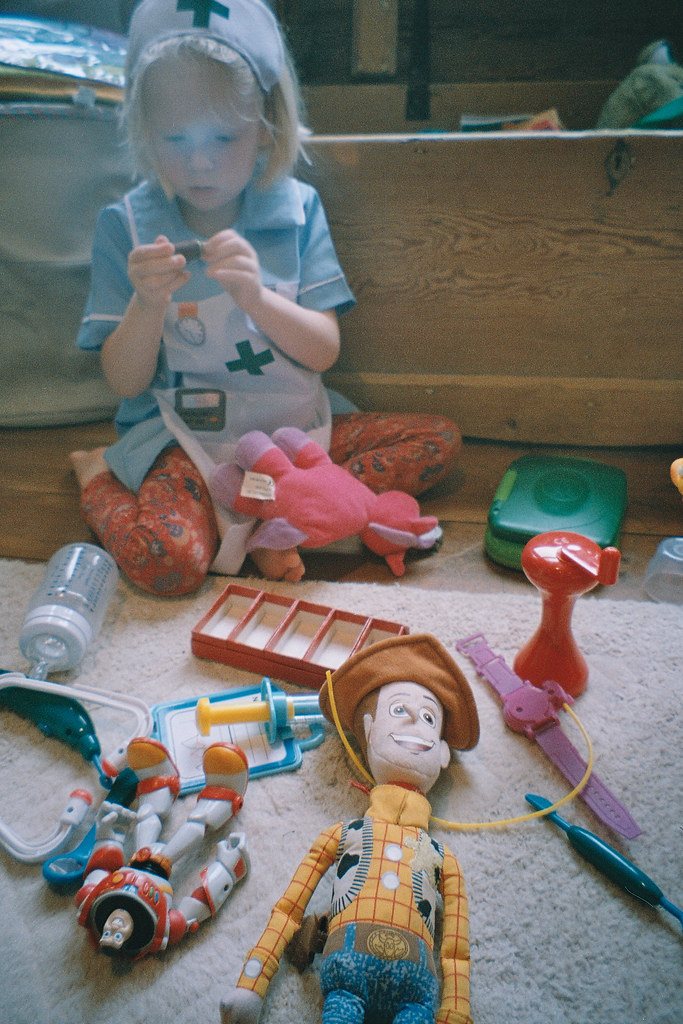
But generally speaking the lens performs quite well I think!
Other features and functions
I’m only going to quickly touch on some of the other modes of the camera. As is often the case with these little reviews, I don’t use all the modes. Case in point, I didn’t use the flash at all. Rest assured though, if you are looking for compact zoom with a flash, it does have one! It also has the usual cacophony of flash off, fill flash, night flash, red eye removal modes. There is also a self timer, and if you have the little IR trigger accessory, it can be triggered remotely. Its third tiny mode button sets it to either the spot mode (as mentioned) or an infinity mode. Lastly it has the oft included rather pointless date modes – and thats pretty much the lot, but for a compact point & shoot, there’s not much requirement for more features than this…
Annoyances & frustrations
All seems positive then? Well not all, it does have a few short comings that I hadn’t really noticed when shooting in the hospital. For a start, the controls are quite fiddly – the little buttons on the back that scroll through various modes are quite hard to press. Typically for a camera of this type, none of the modes are remembered when the camera is switched off either. I find this less irritating than I used to, but on this camera it’s confounded a little bit by the fact that the sliding door on/off switch on the front of the camera is quite easy to close, thus resetting the modes you select if you do it by accident. This problem is magnified further still by the fact that the finger movement involved in using the zoom control is seems to mean my other fingers sometimes push the sliding door shut. I found myself missing a couple of photos just because I’d accidentally switched the camera off, had to wait for it to come back on again, set the modes I wanted again, and then take the photo.
Another frustration is born out of the fact that it’s a passive AF camera. This in itself is fine but it does mean the camera has a AF assist light. Most cameras like this just have a little orange/red AF assist light, not the Olympus mju-iii wide 100, it uses its flash. A very quick series of low level flashes emanate from the pop up flash thus drawing quite a lot of attention to the fact that you are taking a photo of your daughter who sometimes these days gets a bit pissy when you point a camera at her… Thankfully, it doesn’t do this when the flash is switched off, its just not always the most ideal way to be reminded.
Beyond this, I think the thing that annoys me the most about the camera is the pop up flash itself. If you push the flash down, the camera doesn’t work at all. This is unlike many Ricoh cameras (such as the FF90) that allow the flash to be cancelled by pushing it down. Had they made this a feature, I’d be really impressed by this camera… Unfortunately, they didn’t.
My concluding thoughts on the Olympus mju-iii wide 100
I feel a little like this has been quite an unusual review, even by my standards. The first roll I shot with it left me filled with the feeling if success. The second went a little wrong and only reaped a few fairly average photos. At the centre of it all is the Olympus mju-iii wide 100 – a camera that is probably as good as the average of the two experiences…
My choice of this camera for the first roll, was almost serendipitous. It just worked out to be the ideal camera for the job and was there to hand when I wanted it. But, the serendipitous nature of this doesn’t detract from the fact that the three selling points of the camera on that particular occasion are indeed positive attributes. It is fully automatic, but it does give a sense of control over the exposure in the same way the mju-ii can – and doesn’t impose a poor AE program on you like many cameras of its type can. It also has a good 28-100 lens that all be it quite slow, is very good for what is now such an inexpensive camera. It’s also really very discrete – one of the quietest automatic cameras in my current collection in fact. Of course, as is so often the case with these cameras, its positive traits are balanced out with a few negative niggles. If they’d made that flash on top so it would manually cancel the flash on a shot by shot basis, I’d be raving about it – but they didn’t, so I am not.
That said though, I have enjoyed using it a great deal – certainly a lot more than I did that hateful AiBORG recently – and I wouldn’t hesitate to pick it up again. If you are looking for a cheap point & shoot with a decent 28-100mm lens, to date I haven’t found a better option than the Olympus mju-iii wide 100 – though it has started me down a path of trying to find one…
Share this post:
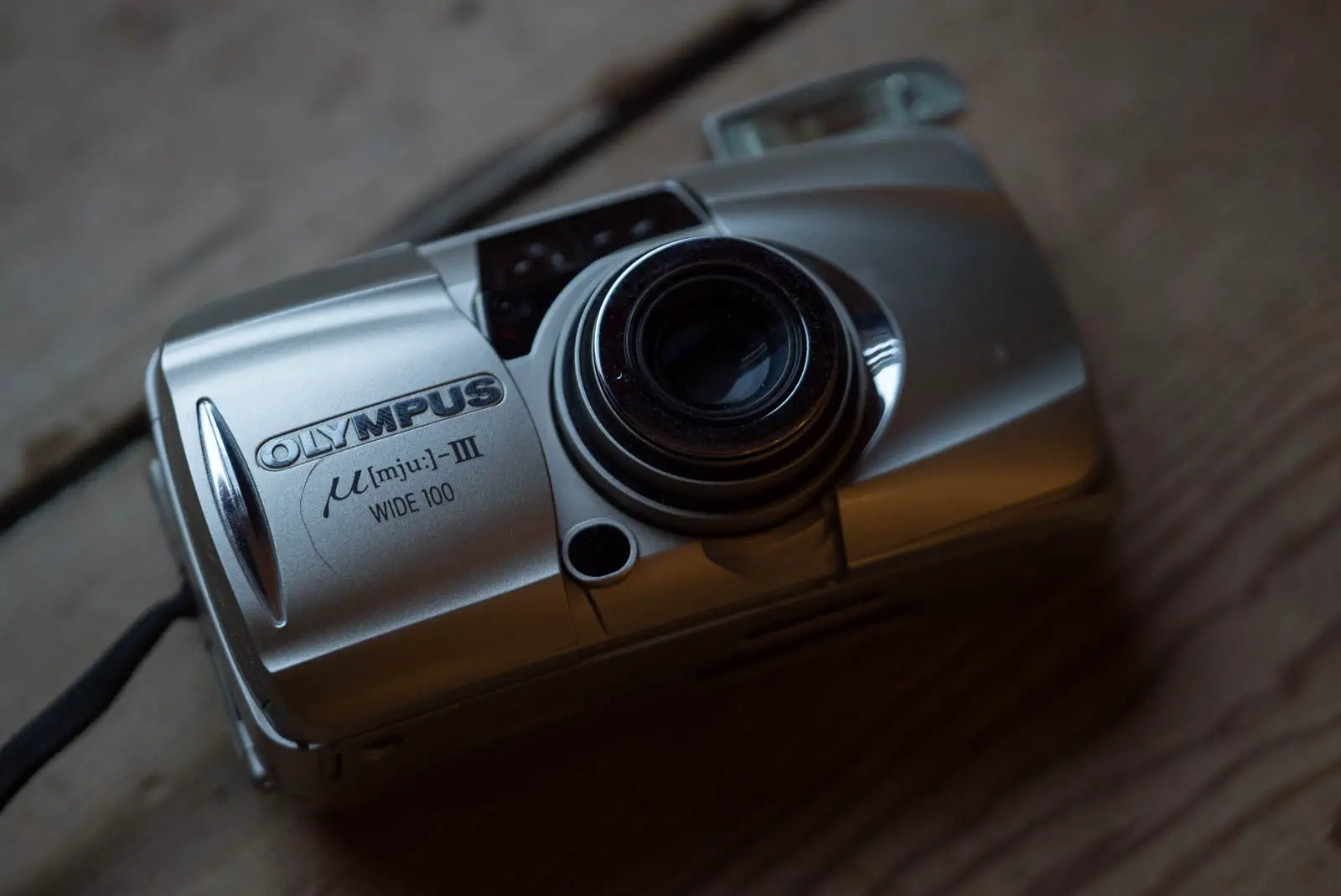
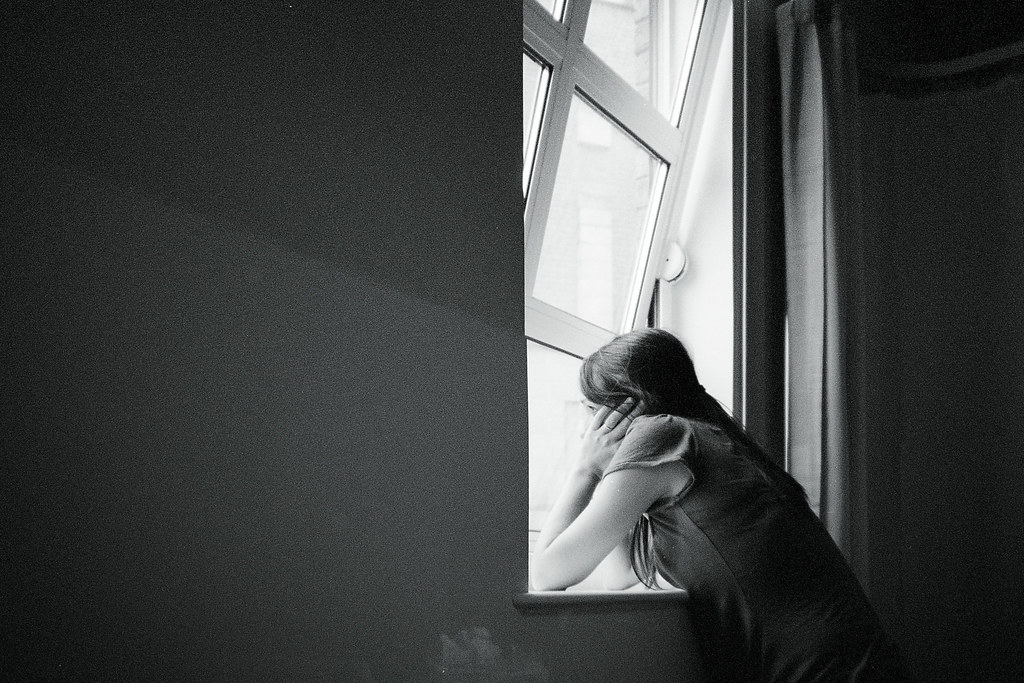
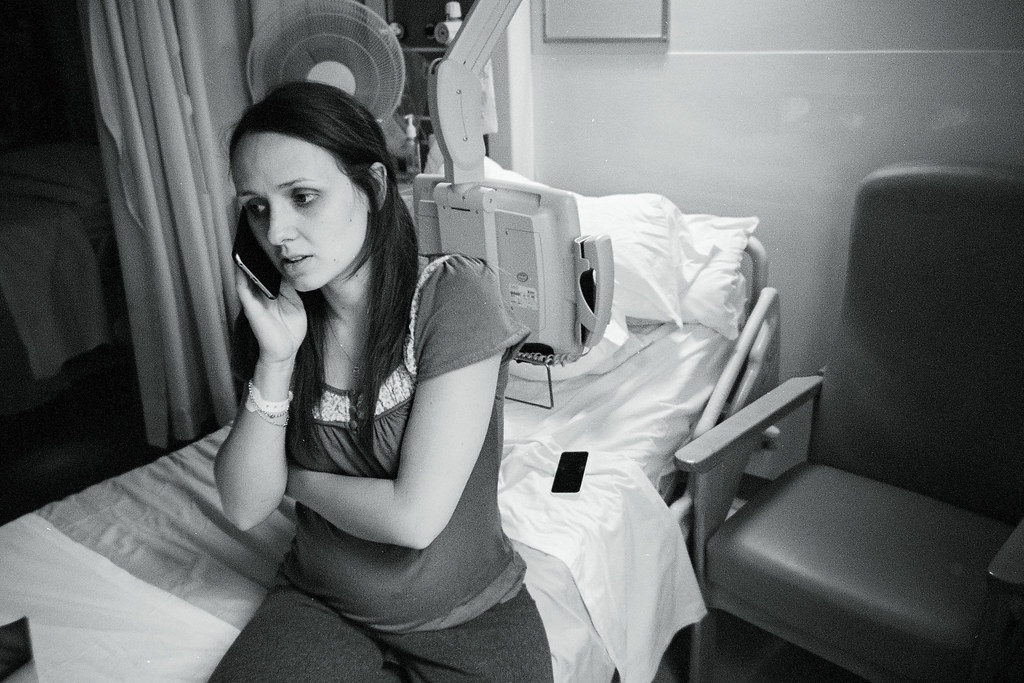
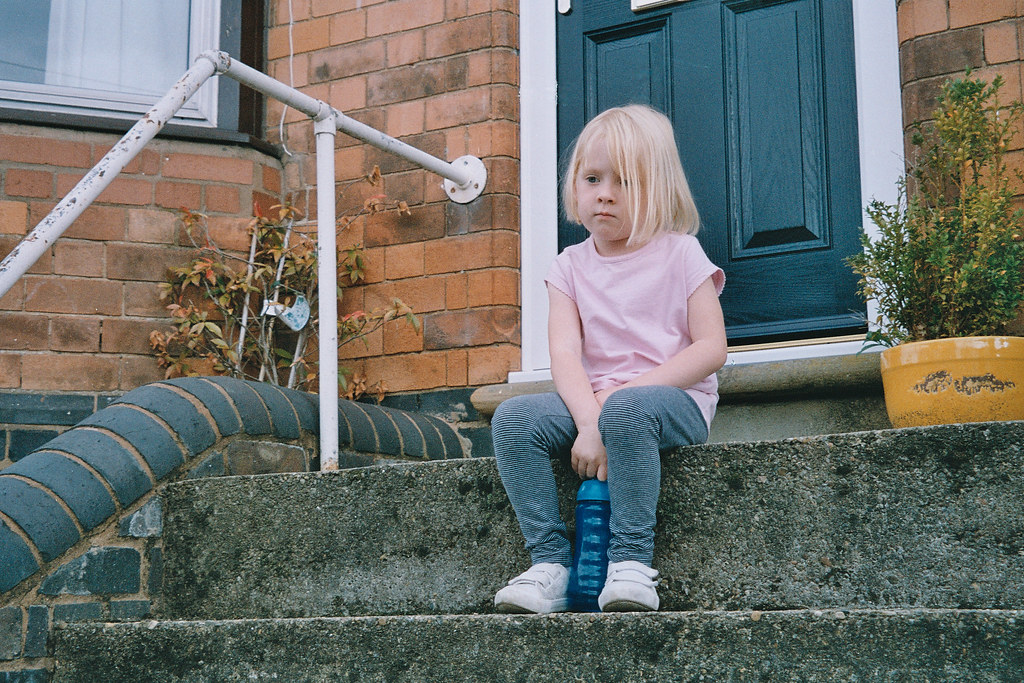
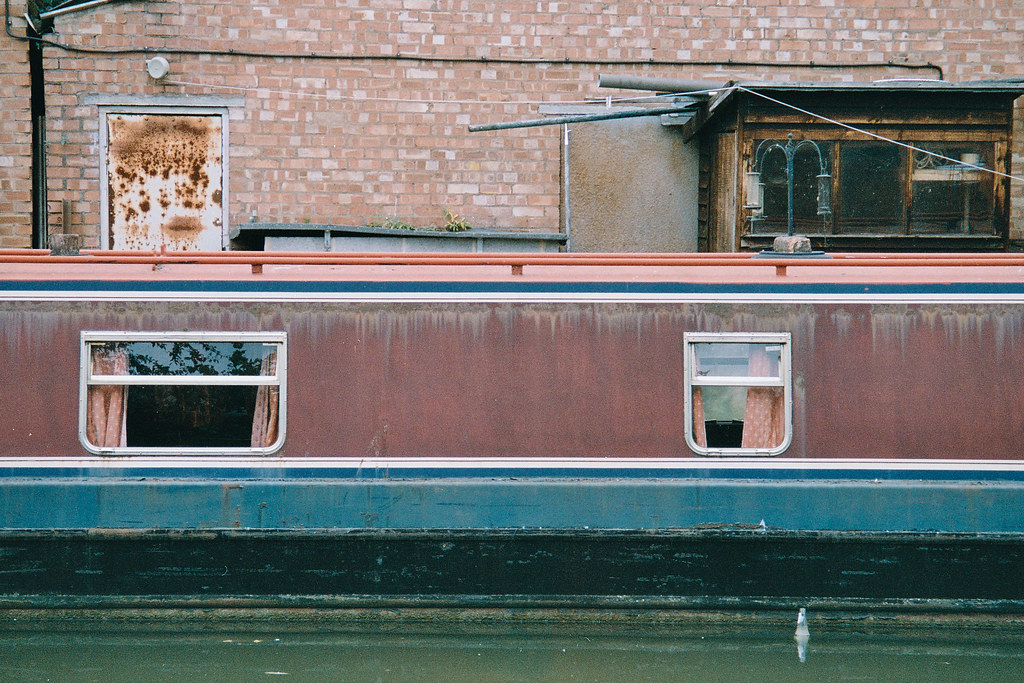








Comments
John Grzinich on Olympus mju-iii wide 100 review
Comment posted: 09/12/2019